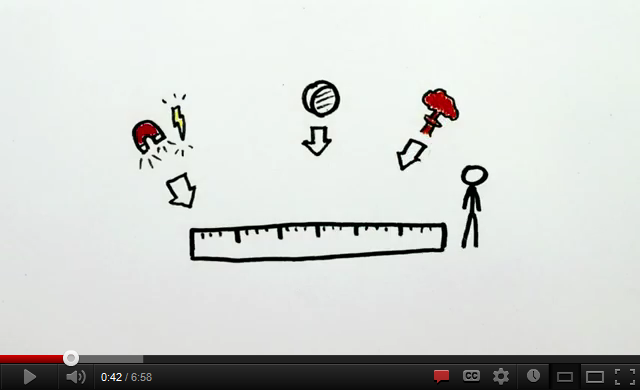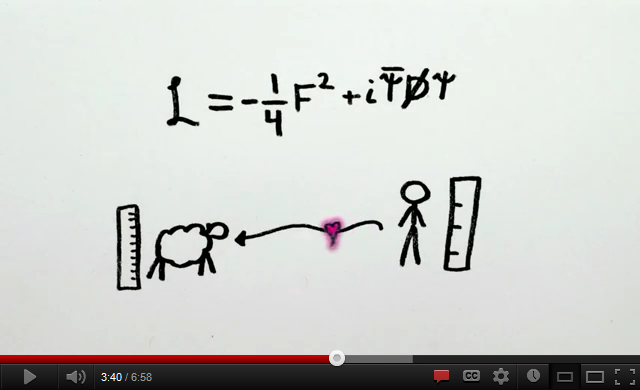Derek Muller sent me this link to a very popular video animation that attempts to explain fundamental forces in nature. You can watch it for yourself below.
The video uses analogy and some cute animations to attempt to explain how forces in nature come from difference between measurements of those forces in different parts of the university. For example look at the screen-shot taken from the video shown below.

If you look at this picture, does it accurately represent the statement given by the narrator? It seems to me that if you are going to use a visual to explain a concept, it should be clear from the visual what you mean. Visuals should support your explanation, and if your analogy strays too far from the concept you are trying to explain, your visuals do more harm than good. What was the first thing you thought of when you looked at this visual? I bet it wasn’t "Measurement by itself is meaningless, but as surprising as it sounds, that meaningless is exactly what causes the fundamental forces in nature" which is what the narrator says at this moment.
Here’s another screen-shot.

This visual says two things. The first is not stated by the narrator, but is suggested by the equation shown, specifically that what we are going to look at next is very complicated. The second is suggested by the crossing out of the word Quantum. In this case, the visual definitely describes what the narrator is going to do in the rest of the video – ignore quantum effects on the four fundamental forces. The bad news here is that ignoring quantum effects means that whatever follows is going to be out of date by 100 years of science, and not necessarily a very good representation of the apparent strangeness of the universe. In other words, what follows is a bad model that one will probably not understand.
Now let’s see what happens next.

My question here is, what of the previous 1 minute and 30 seconds do you remember? I’m going to suggest that you probably do not remember much. This new model is so vastly different than the old model the narrator starts with (and that previous model was not well explained, as you may recall) that the transference of the introductory model to this new model is not likely to happen. If you happen to be an expert in the area of the fundamental forces of nature, you may not notice this effect, since the earlier model is (maybe) describing something you already understand, and have already internalized. If you are not an expert, I very much doubt that a 1 minute explanation is going to make you one.
Further, if you look at this section, you may notice the model for currency transaction (which looks a lot like a function machine, an analogy mathematics teachers often use to explain functions to students) in the middle of the currency exchange. The currency portion of this implicit analogy probably makes sense, but the symbol in the middle may be lost on a lot of people, particularly since the narrator doesn’t take the time to explain what this symbol means.

Now this is where the narrator makes a huge assumption. He assumes that people have been able to make a somewhat over-arching generalization from his single example. He says, "Hopefully now you can see why measuring things differently in different places inevitably gives rise to a long range interaction, mediated by a particle." I doubt that anyone would be able to make that generalization without a fair amount of expertise in long-range interactions themselves.
It is a form of cognitive bias to assume that because an analogy makes sense to you, that it will make to other people. Analogies are useful as a sense making activity when the analogy describes a shared experience between two people, and very few people have an experience of currency exchange (surprisingly, only a small percentage of any population travels to other countries). In other words, using an analogy that people lack experience with is unlikely to lead to further understanding of a more complicated phenomena.
This particular video, when I watched it, had over 156, 000 views, and over 5000 likes, which suggests to me that one cannot take the popularity of a video and use it to gauge the effectiveness of the learning from the video. I recommend reading the comments on the video. You will see more than a few people who are confused by the video, or who add messages which are essentially unrelated from the video itself. The most popular discussion point I saw, in the 100 or so comments I read, was that this "minutephysics" video was in fact longer than a minute.
My complaints while directed at this one video are generalizable. Analogies used in videos should be related to common experiences, where possible. Visuals matter – using visuals which are confusing, or even wrong, not only distracts from the intended objectives of the videos, it can introduce other possible misconceptions. Avoiding people’s misconceptions in the videos, and attempting to present clear explanations means that people will, in general, incorporate the new information into their existing schema, leaving their current misconceptions intact.
This comment on the video essentially summarizes my main point (notice how many people agree with it).
